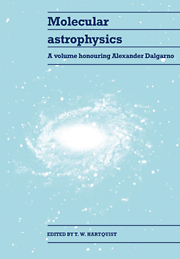Book contents
- Frontmatter
- Contents
- Dedication
- Preface
- Part I Molecular clouds and the distribution of molecules in the Milky Way and other galaxies
- Part II Diffuse molecular clouds
- Part III Quiescent dense clouds
- Part IV Studies of molecular processes
- Part V Atomic species in dense clouds
- Part VI H2 in regions of massive star formation
- 19 Infrared observations of line emission from molecular hydrogen
- 20 Shocks in dense molecular clouds
- 21 Dissociative shocks
- 22 Infrared molecular hydrogen emission from interstellar photodissociation regions
- Part VII Molecules near stars and in stellar ejecta
- Part VIII Moderately ionized gas and chemistry at large redshifts
- Index
21 - Dissociative shocks
Published online by Cambridge University Press: 10 December 2009
- Frontmatter
- Contents
- Dedication
- Preface
- Part I Molecular clouds and the distribution of molecules in the Milky Way and other galaxies
- Part II Diffuse molecular clouds
- Part III Quiescent dense clouds
- Part IV Studies of molecular processes
- Part V Atomic species in dense clouds
- Part VI H2 in regions of massive star formation
- 19 Infrared observations of line emission from molecular hydrogen
- 20 Shocks in dense molecular clouds
- 21 Dissociative shocks
- 22 Infrared molecular hydrogen emission from interstellar photodissociation regions
- Part VII Molecules near stars and in stellar ejecta
- Part VIII Moderately ionized gas and chemistry at large redshifts
- Index
Summary
Introduction
Fast shocks destroy molecules. Whereas the compressive and heating effects of slow shocks profoundly alter the chemical composition of a molecular gas but leave its molecular nature intact, interstellar shocks travelling faster than about 50 km s−1 result in the complete and very rapid dissociation of any pre-existing molecules by collisional processes (see Figure 3 in McKee, Chernoff and Hollenbach 1984), and if the shock velocity exceeds 70 km s−1, the atomic dissociation products are then largely ionised. Shocks faster than 80 km s−1 generate enough ultraviolet radiation to destroy molecules by photoionisation before they even reach the shock front (Hollenbach and McKee 1989).
Dissociative shocks may be present in the interstellar medium wherever gas is moving supersonically at velocities greater than 50 km s−1. Such velocities of bulk motion may result from the outflow of material from young stellar objects, from stellar winds, or from supernova explosions. Clearly, dissociative shocks are intimately associated with stars: they may be generated during the birth, throughout the life and by the explosive death of stars. Emission from fast shocks may serve as a tracer of active star formation in the Galaxy.
Despite the extremely destructive effects of fast shocks, molecules can reform behind a passing dissociative shock before the shocked gas has cooled to the temperature of the ambient, unshocked medium. Free electrons produced behind the shock front initiate the process by catalysing H2 formation. The rapid return of a dissociated shocked plasma to the molecular phase is a striking demonstration of the tendency toward molecule formation in the interstellar medium.
- Type
- Chapter
- Information
- Molecular AstrophysicsA Volume Honouring Alexander Dalgarno, pp. 374 - 383Publisher: Cambridge University PressPrint publication year: 1990
- 3
- Cited by

